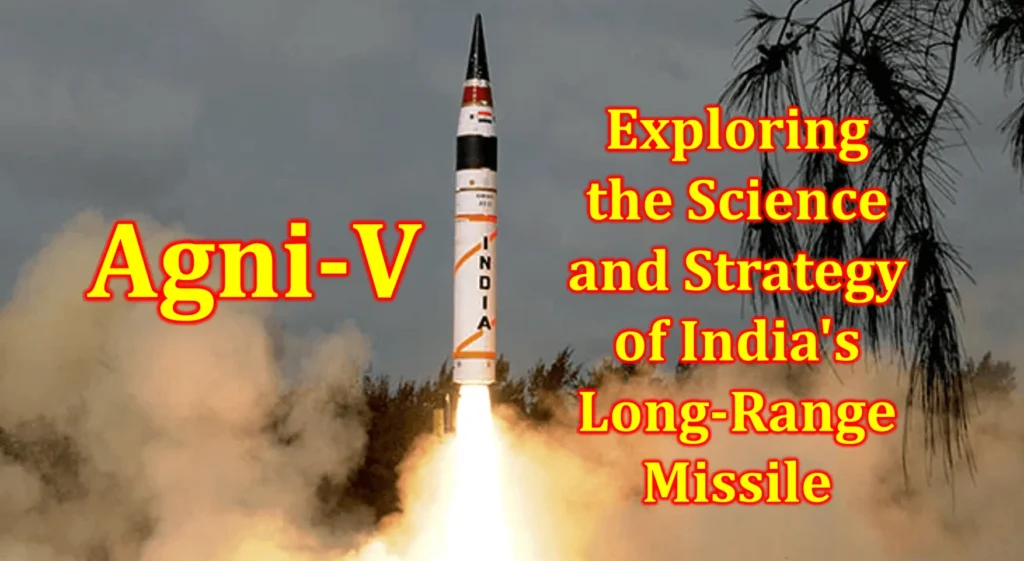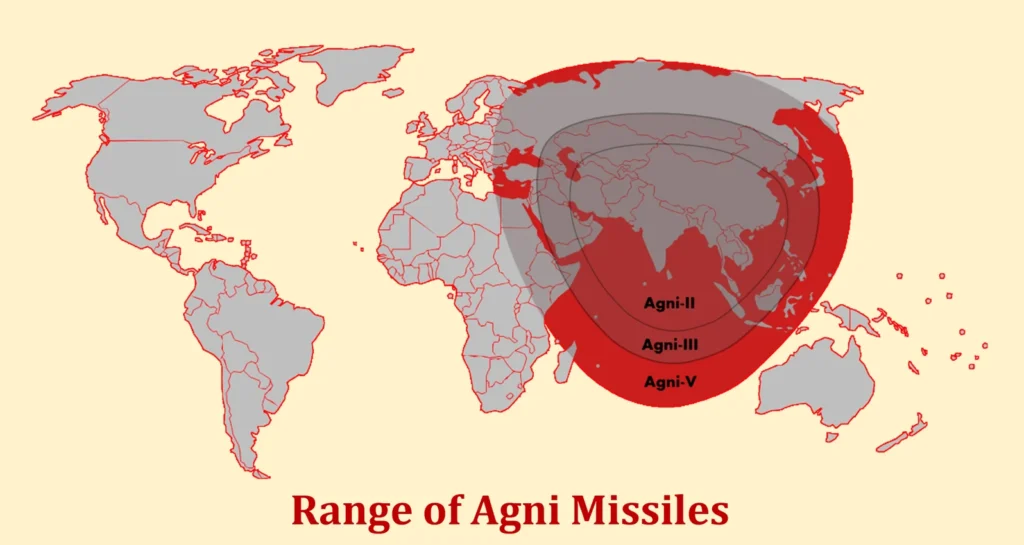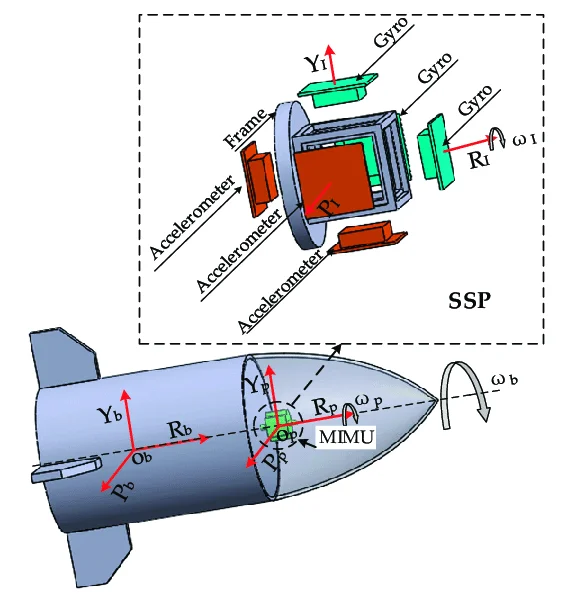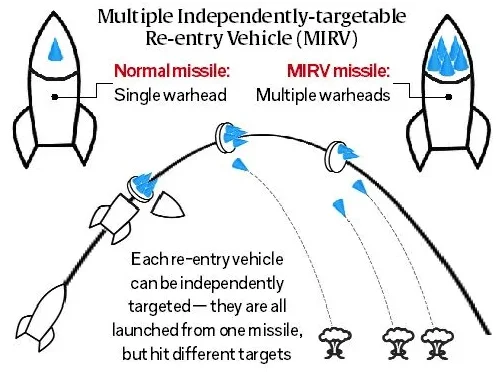
Introduction
Agni V, named after the Sanskrit word for “fire,” stands as India‘s formidable land-based intercontinental ballistic missile (ICBM), boasting nuclear capabilities. Developed by India’s Defense Research and Development Organization (DRDO), this missile is a testament to India’s advancements in military technology. Its impressive range, exceeding 7,000 kilometers, makes it a potent force on the global stage.
Capabilities of Agni V
This three-stage, road-mobile missile is solid-fueled and canisterized, providing ease of transport and deployment. What sets Agni V apart is its ability to carry multiple independently targetable re-entry vehicles (MIRVs), enhancing its effectiveness in striking various targets with precision.
Development and Deployment
Agni V’s development was spurred by India’s strategic need to bolster its nuclear deterrence against potential adversaries, particularly China. The limitations of previous missile ranges prompted the pursuit of it, ensuring coverage of vital regions previously beyond reach. Spearheaded by senior defence scientist M. Natarajan, the project aimed to create a missile surpassing 5,000 kilometers in range.
After rigorous testing and development, Agni V was officially deployed by India’s Strategic Forces Command in 2018, marking a significant milestone in the nation’s defense capabilities. Its induction into the armed forces underscores India’s commitment to maintaining a robust nuclear deterrent.
Allegations on Agni V
While Chinese researchers speculate about its extended range of 8,000 kilometers, India remains focused on leveraging this potent weapon to safeguard its interests across Asia and potentially beyond. With ongoing advancements and potential upgrades, it continues to evolve as a cornerstone of India’s national security strategy.
A Comprehensive Analysis
Propulsion and Design
It stands as a testament to India’s prowess in missile technology, featuring a three-stage solid-fueled design with composite motor casings in the second and third stages. Building upon the legacy of Agni-3, this missile integrates extensive composite materials to reduce weight while expanding its range to intercontinental distances. The first flight test in 2012 lasted 1130 seconds, with the first stage igniting for 90 seconds, showcasing its formidable capabilities.
Range Controversy

The exact range of it remains shrouded in secrecy, with conflicting reports from different sources. While DRDO Chief V. K. Saraswat initially hinted at a range of 5,500–5,800 km, Chinese researchers claim a significantly higher range of around 8,000 kilometers. The missile’s true capabilities, veiled by strategic discretion, add layers of intrigue to its formidable presence.
Guidance and Control Systems

It is outfitted with sophisticated guidance systems, and for accurate targeting, it uses an inertial navigation system (RLG-INS) based on a ring laser gyroscope. Additionally, it features a micro inertial navigation system (MINGS) as a backup, capable of interfacing with various satellite navigation systems. These sophisticated control mechanisms, developed by the Research Centre Imarat, ensure unparalleled accuracy in trajectory and destination.
Mobility and Deployment
Tailored for road mobility, it leverages a canister launch system, enabling swift deployment from pre-surveyed launch locations. The utilization of maraging steel canisters ensures hermetic sealing, preserving the missile for extended periods. With a dedicated Transport-cum-Tilting vehicle, the launcher guarantees rapid response capabilities, reducing reaction times to mere minutes.
Advanced Features: MIRVs and ASAT
The Agni V ballistic missile, a cornerstone of India’s defense strategy, incorporates advanced technologies including MIRVs (Multiple Independently Targetable Re-entry Vehicles) and ASAT (Anti-Satellite) capabilities, enhancing its versatility and effectiveness in various operational scenarios.
MIRVs: Enhancing Strike Capabilities
MIRVs enable a single ballistic missile to carry multiple warheads, each capable of independent targeting. This capability significantly enhances the strike capabilities of the Agni V missile, allowing it to engage multiple targets with a single launch. With MIRVs onboard, Agni V can effectively counter sophisticated air defense systems and saturate enemy defenses, increasing the likelihood of mission success.

The deployment of MIRVs also introduces a level of strategic ambiguity, as adversaries are forced to contend with the uncertainty of how many warheads a single Agni V missile may carry. This deters potential aggressors and reinforces India’s deterrence posture, thereby enhancing regional stability.
ASAT: Countering Space Threats
In addition to its conventional strike capabilities, Agni V is equipped with ASAT capabilities designed to neutralize threats in space. The successful test of India’s ASAT weapon in March 2019 demonstrated the country’s ability to destroy satellites in low Earth orbit, marking a significant milestone in India’s space and defense capabilities.
The integration of ASAT capabilities into the Agni V missile system enhances India’s ability to safeguard its space assets and counter potential threats from adversarial powers. By targeting satellites, which are critical for communication, navigation, and surveillance, Agni V’s ASAT capabilities serve as a deterrent against space-based aggression and coercion.
Synergy of Capabilities
The incorporation of MIRVs and ASAT capabilities into the Agni V missile system represents a strategic synergy of offensive and defensive capabilities. Together, these technologies provide India with a comprehensive deterrent posture, capable of addressing threats across multiple domains – from land and sea to air and space.
Furthermore, the integration of MIRVs and ASAT capabilities underscores India’s commitment to technological innovation and self-reliance in defense. By leveraging indigenous expertise and advancements in science and technology, India continues to enhance its strategic capabilities and assert its position as a responsible global player in the realm of defense and security.
Strengthening India’s Defense Posture
The incorporation of MIRVs and ASAT capabilities into the Agni V ballistic missile system represents a significant leap forward for India’s defense capabilities. These advanced technologies enhance the missile’s strike capabilities and enable it to counter threats across multiple domains, reinforcing India’s deterrence posture and safeguarding its national security interests. As India continues to evolve its defense capabilities, the Agni V missile system stands as a testament to the country’s commitment to technological innovation and strategic self-reliance.
It epitomizes India’s relentless pursuit of technological excellence in the realm of missile development. With its formidable range, precision guidance, and adaptable deployment strategies, it serves as a cornerstone of India’s national security framework, ensuring deterrence and defense in an increasingly complex geopolitical landscape.
Testing Agni-V: A Chronicle of Milestones
Preparation for Testing
As anticipation mounted, India’s then Defense Minister A. K. Antony urged defense scientists to expedite the demonstration of its capabilities, emphasizing its crucial role in India’s defense strategy. DRDO chief V. K. Saraswat’s reassurances in mid-2011 regarding the completion of ground tests further fueled expectations. Logistics posed a challenge, with the missile’s trajectory spanning the Indian Ocean, necessitating coordination with countries like Indonesia and Australia. The meticulous planning involved positioning Indian Navy warships equipped with tracking systems along the test path, ensuring safety and accuracy.
Reactions to Testing
Domestic Acclaim: The successful launch garnered widespread acclaim domestically, with Prime Minister Manmohan Singh and Defense Minister A. K. Antony lauding DRDO’s achievement. Avinash Chander, Missile Program Director, hailed the launch as emblematic of significant strides in India’s defense capabilities. Subsequent tests, including the nuclear-capable version in 2021 and the MIRV-equipped version in 2024, elicited praise from Prime Minister Narendra Modi and Defense Minister Rajnath Singh, underscoring India’s technological prowess.
International Responses
- NATO: NATO Secretary General Anders Fogh Rasmussen downplayed India’s missile capabilities, affirming that India posed no threat to NATO or its allies.
- United States: The US commended India’s non-proliferation record and expressed comfort with India’s progress in missile technology, contrasting it with North Korea’s activities.
- United Kingdom: The BBC highlighted India’s entry into the “elite nuclear club,” acknowledging its significance in global geopolitics.
- Pakistan: Pakistani officials, while informed in advance of the test as per bilateral agreements, showed minimal concern, according to reports.
- China: While acknowledging the historic nature of India’s achievement, China’s response was mixed, with state media highlighting perceived shortcomings of Agni-V. Despite reservations, China emphasized the importance of maintaining friendly cooperation.
The testing of Agni-V represents a significant chapter in India’s quest for technological excellence in defense. Amid domestic acclaim and international scrutiny, India asserts its position as a responsible nuclear power, balancing strategic imperatives with global peace and stability. As India continues to push the boundaries of missile technology, Agni-V stands as a testament to the nation’s indomitable spirit and relentless pursuit of security and progress.
Paving the Path for India’s Future in Missile Technology
As India celebrates the successful development and testing of the Agni V ballistic missile, attention naturally shifts towards its future prospects and the implications it holds for India’s defense strategy. Agni V, with its impressive range and capabilities, has not only solidified India’s position in the global defense arena but also opened up new avenues for exploration and advancement in missile technology.
Advancements in Accuracy and Payload
One of the key areas for the future development of Agni V lies in enhancing its accuracy and payload capacity. As technology continues to evolve, India’s defense research organizations are tirelessly working towards refining the guidance systems of Agni V to ensure pinpoint accuracy. Moreover, efforts are underway to increase its payload capacity, enabling it to carry a variety of warheads and payloads tailored to specific mission requirements.
Extended Range and Strategic Reach
The future of Agni V also holds promise in terms of extending its range capabilities. While Agni V already boasts an impressive range exceeding 5,000 kilometers, ongoing research and development efforts aim to push the boundaries further. With an extended range, Agni V could potentially reach targets even beyond its current capabilities, thereby enhancing India’s strategic reach and deterrence posture.
Integration of Advanced Technologies
Incorporating advanced technologies is another avenue for the future development of Agni V. From leveraging artificial intelligence for autonomous targeting to integrating stealth features for enhanced survivability, India is exploring various technological innovations to augment the capabilities of Agni V. Additionally, advancements in propulsion systems and materials science hold the promise of further enhancing the performance and reliability of the missile.
Strategic Implications and Global Dynamics
Looking ahead, the future of Agni V will undoubtedly have significant strategic implications, both regionally and globally. As India continues to assert itself as a responsible nuclear power, the deployment of Agni V serves as a credible deterrent against potential adversaries. Moreover, the growing sophistication of India’s missile capabilities will undoubtedly influence the geopolitical dynamics of the region, shaping strategic calculations and alliances.
Conclusion & FAQs
In conclusion, the future prospects of Agni V represent a testament to India’s commitment to advancing its defense capabilities and ensuring national security. As India navigates the complex geopolitical landscape, Agni V stands as a symbol of technological prowess and strategic deterrence. With ongoing research and development efforts aimed at enhancing its capabilities, Agni V is poised to play a pivotal role in shaping India’s defense landscape for years to come, safeguarding the nation’s sovereignty and interests in an increasingly uncertain world.
Frequently Asked Questions (FAQs)
What is the Agni V ballistic missile, and what are its key features?
India’s Defense Research and Development Organization (DRDO) is responsible for the development of the Agni V intercontinental ballistic missile (ICBM). It is the fifth missile in the Agni series and is characterized by its long-range capability, with a reported range exceeding 5,000 kilometers. Agni V is designed to deliver nuclear warheads and possesses advanced guidance and navigation systems for precise targeting.
How many successful test flights has Agni V conducted so far?
As of the latest available information, Agni V has undergone multiple successful test flights. These tests have demonstrated the missile’s reliability and performance, reaffirming India’s progress in indigenous missile technology.
What is the significance of Agni V for India’s defense capabilities?
Agni V holds immense significance for India’s defense posture, as it provides the country with a credible deterrent against potential adversaries. With its long-range capabilities, Agni V enhances India’s strategic reach and ensures the nation’s ability to deter and respond to threats effectively.
How does Agni V contribute to India’s national security strategy?
Agni V plays a crucial role in India’s national security strategy by bolstering the country’s nuclear deterrence capabilities. As a potent missile system, Agni V serves as a deterrent against aggression and strengthens India’s ability to defend its sovereignty and territorial integrity.
What are the future prospects for Agni V in terms of technological advancements?
The future of Agni V holds promise for further technological advancements aimed at enhancing its accuracy, range, and payload capacity. India’s defense research organizations are continually working to integrate advanced technologies, such as artificial intelligence and stealth features, to augment the capabilities of Agni V and ensure its effectiveness in evolving threat environments.
How does Agni V contribute to India’s status in the global defense arena?
Agni V elevates India’s status as a responsible nuclear power and a significant player in the global defense landscape. Its development and successful testing showcase India’s indigenous technological capabilities and its commitment to maintaining a credible deterrence posture while adhering to international norms and obligations.
What measures are in place to ensure the safety and security of Agni V missile systems?
The safety and security of Agni V missile systems are paramount concerns for India’s defense establishment. Stringent protocols and procedures are implemented throughout the lifecycle of the missile, including design, production, testing, deployment, and operational phases, to mitigate risks and prevent unauthorized access or misuse.
How does Agni V contribute to India’s defense research and industrial base?
The development and testing of Agni V provide valuable insights and expertise that contribute to the growth and advancement of India’s defense research and industrial base. It fosters collaboration between government agencies, research institutions, and the private sector, driving innovation, skill development, and indigenous capabilities in missile technology.
